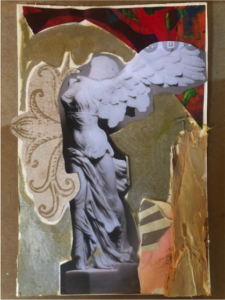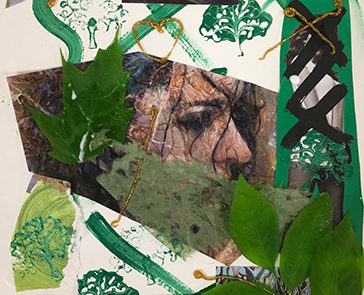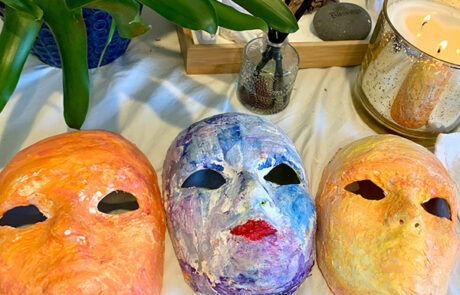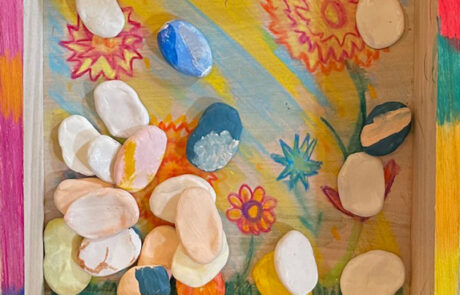
Art therapy is a mental health profession that emerged in the early 20th century when professionals first recognized the profound connection between creative expression and emotional release. It combines art-making with psychological techniques to tap into the transformative power of imagination and unconscious wisdom.
Art therapy has been shown to decrease depression and anxiety, diminish symptoms of PTSD, and boost the memory of Alzheimer’s patients. In a landmark study done at Northwestern Hospital, art therapy significantly reduced the side effects of chemotherapy, including fatique and pain, to name a few. Further, according to the American Art Therapy Association, art therapy is also used to improve cognitive and sensory functioning, to foster self-esteem and resilience, and to reduce and resolve distress.
Art therapy supports clients in safely expressing and processing things that may not be consciously known or cannot be said as a path to coping, insight, and to visualize forward path. Through an understanding of personal and collective symbols and metaphors, both the process and the end products of art therapy offer profound opportunities for healing and growth that extend far beyond the immediate moment. While it is the role of the art therapist to facilitate this process, it is the clients’ understanding of the images made that always holds sway
Art therapists use a full range of media and interventions to support clients in symptom reduction. This includes decreasing difficult emotions or body sensations that may be associated with pain or trauma and stored in the body.
There is no artistic experience required to participate in art therapy, nor is there is no right or wrong way to create. Rather, it is a personal journey of self-expression and exploration that can be filled with curiosity and courage, intention and spontaneity. Regardless of the path taken, the result is always a valuable gift of insight, wisdom, compassion and connection.
As an art therapist, I embrace a transpersonal and contemplative approach. Transpersonal signifies my belief in the existence of dimensions and information beyond what is immediately visible or known. In my art therapy practice, I incorporate guided meditations, mindfulness practices, ritual, and intention to deepen the connection to these hidden realms while fostering a sense of interconnectedness with all living things.
For further information about art therapy, please visit www.aata.org.

Art therapy is a mental health profession that emerged in the early 20th century when professionals first recognized the profound connection between creative expression and emotional release. It combines art-making with psychological techniques to tap into the transformative power of imagination and unconscious wisdom.
Art therapy has been shown to decrease depression and anxiety, diminish symptoms of PTSD, and boost the memory of Alzheimer’s patients. In a landmark study done at Northwestern Hospital, art therapy significantly reduced the side effects of chemotherapy, including fatique and pain, to name a few. Further, according to the American Art Therapy Association, art therapy is also used to improve cognitive and sensory functioning, to foster self-esteem and resilience, and to reduce and resolve distress.
Art therapy supports clients in safely expressing and processing things that may not be consciously known or cannot be said as a path to coping, insight, and to visualize forward path. Through an understanding of personal and collective symbols and metaphors, both the process and the end products of art therapy offer profound opportunities for healing and growth that extend far beyond the immediate moment. While it is the role of the art therapist to facilitate this process, it is the clients’ understanding of the images made that always holds sway
Art therapists use a full range of media and interventions to support clients in symptom reduction. This includes decreasing difficult emotions or body sensations that may be associated with pain or trauma and stored in the body.
There is no artistic experience required to participate in art therapy, nor is there is no right or wrong way to create. Rather, it is a personal journey of self-expression and exploration that can be filled with curiosity and courage, intention and spontaneity. Regardless of the path taken, the result is always a valuable gift of insight, wisdom, compassion and connection.
As an art therapist, I embrace a transpersonal and contemplative approach. Transpersonal signifies my belief in the existence of dimensions and information beyond what is immediately visible or known. In my art therapy practice, I incorporate guided meditations, mindfulness practices, ritual, and intention to deepen the connection to these hidden realms while fostering a sense of interconnectedness with all living things.
For further information about art therapy, please visit www.aata.org.



